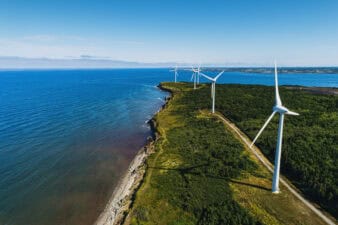Renewable energy stocks underperformed last year, although they could rebound in this year. Brendan Caldwell, president of Caldwell Investment Management, expects the sector to deliver better results due to the evolving macro environment. He said, “I like these renewable stocks on the basis that I do believe that you’re going to see a continued demand for energy.”
Caldwell added, “So, I think you might see in 2022 these renewables have a second wind.” Investors should be patient with growth stocks like Brookfield Renewable Partners (TSX:BEP.UN)(NYSE:BEP), Northland Power (TSX:NPI), and Boralex (TSX:BLX). The stocks are in negative territory to start the year but could break out with the renewed demand for power.
Growing opportunities
Brookfield Renewable is a buying opportunity right now. The share price of $43.33 is 28% lower than a year ago, although market analysts see a potential upside of 22.46% to 47.15% in 12 months. This utility stock pays a 3.6% dividend.
The $11.63 billion company invests in wind, solar, and hydroelectric generation assets, including energy storage facilities. Decarbonization is a global trend, and Brookfield’s assets are in North America, South America, Europe, and Asia. With decarbonization becoming a global trend, the company should be benefit greatly.
Its CEO Connor Teskey said, “As decarbonization of the global economy continues to move to the forefront, we are well-positioned to capture the growing opportunity while earning strong returns for our investors.” Expect Brookfield to secure more power-purchase agreements to contract its renewable energy sources.
Sustainable infrastructure assets
Toronto-based Northland Power is a clean and green developer, constructor, owner, and operator of sustainable infrastructure assets. The $8.44 billion company is one of Canada’s first independent power producers (IPP). Currently, Northland is present in eight countries and boasts a significant inventory of early to mid-stage development opportunities.
Northland’s well-diversified portfolio of high-quality power infrastructure assets is a competitive advantage. About 95% of revenues come from long-term contracts with credit-worthy government counterparties. Apart from its present three GW operating capacity, management has identified significant development opportunities (four to five GW) across multiple markets.
Management is preparing to position Northland for the new wave of global decarbonization. Also, it expects to achieve an adjusted EBITDA of more than $2.5 billion by the latter half of the decade. The share price is $35.48, while the dividend yield is 3.37% if you invest today. Market analysts’ 12-month average price target is $47.83 (+34.81%).
Robust business model
Boralex acquires and develops renewable energy production sites that deliver attractive, risk-adjusted returns on invested capital. According to management, growth is firmly grounded in a long-term vision. The $3.48 billion company operates in Canada, France, and the United States.
Because 99% of capacity is under long-term contracts with companies with strong financial positions, Boralex maintains a robust business model. The average remaining term is 13 years. Right now, the strategic plan is to make the U.S. the priority market, while the extending its presence in Europe.
The utility stock trades at $30.92 per share and pays a decent 2.11% dividend. Based on analysts’ forecast, the price could climb 51.13% in one year.
Expansion mode
Most of the companies in the renewable sector are in expansion mode. Industry experts say they can negotiate for higher rates for their utilities as inflation rises.







